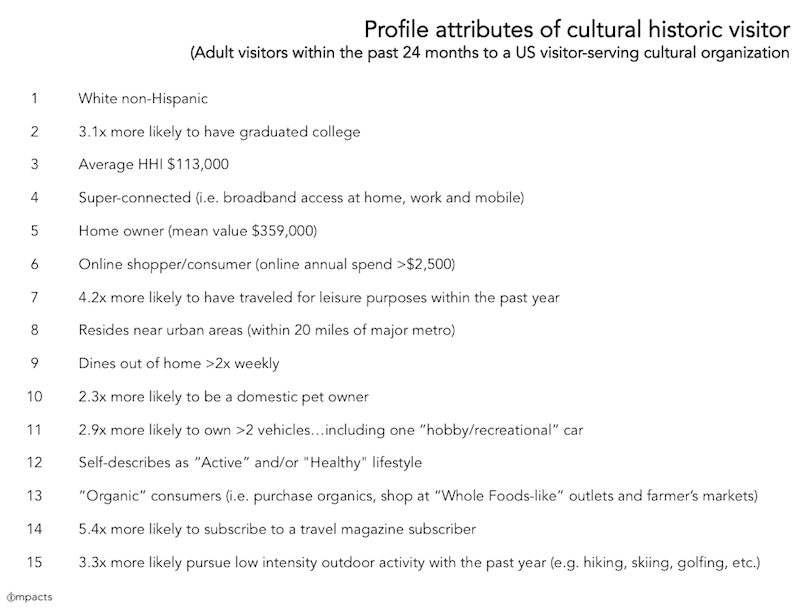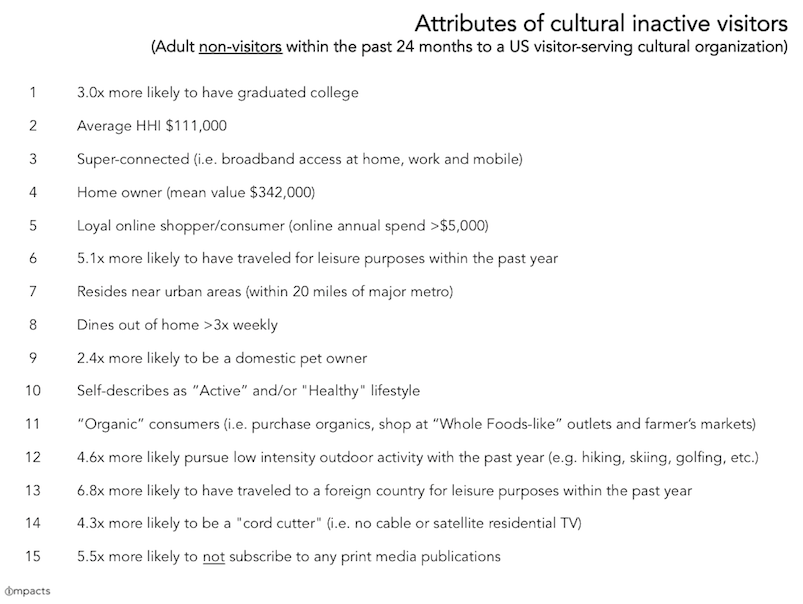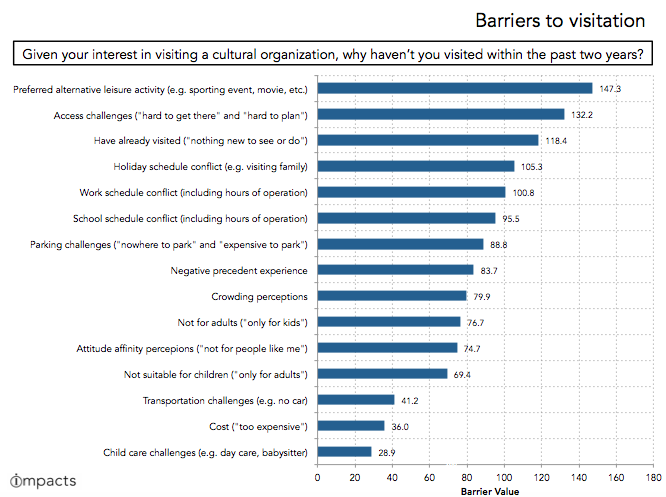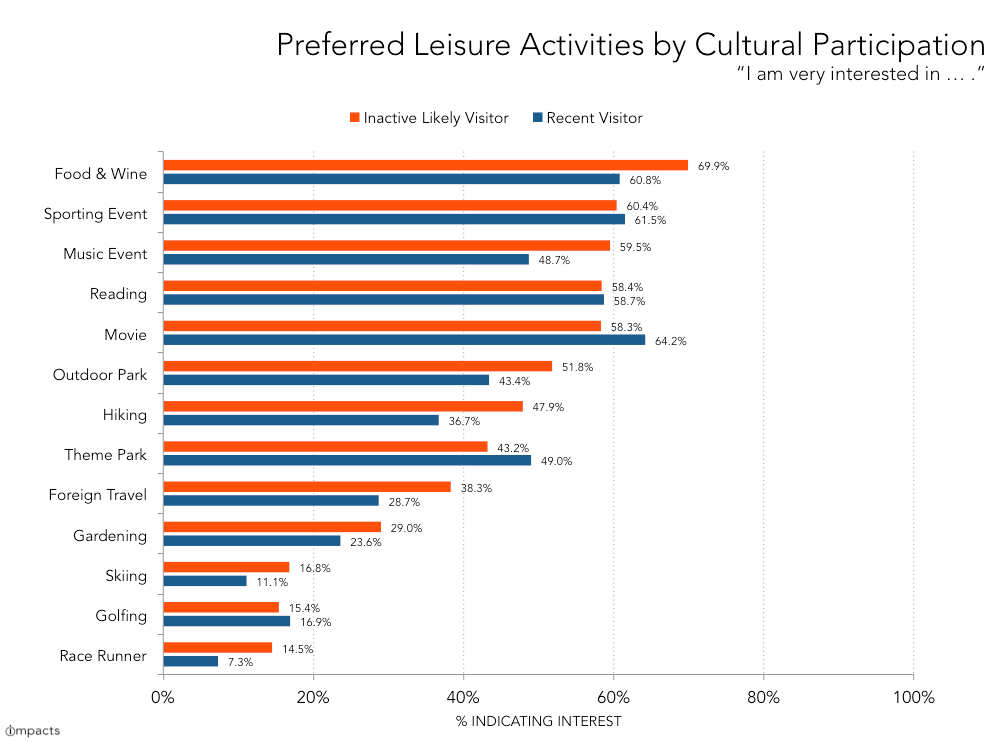Here’s what we know about people in the US who have interest in visiting cultural organizations but haven’t done so in the last two years or longer.
Not everybody wants to visit cultural organizations – but the folks who do fall into two categories: Active visitors and inactive visitors. Active visitors have attended any kind of cultural organization – from an aquarium, to a science center, to a performing arts entity – within the last two years.They make up 16% of the US population. Last week, I shared an article about who these people are as a group, some of what we know about them, and why they matter.
This week, I’ll focus on inactive visitors. These are folks who have interest in visiting a cultural organization – or profile as being likely to have interest – but who have not attended within the last two years.
Here’s what your organization needs to know about these individuals.
16% of the US population has interest in attending cultural organizations, but hasn’t in the last two years or longer.
Inactive visitors have either directly expressed interest in attending or profile as having an increased likelihood of attending because they share many characteristics and attributes with historic visitors, but who – for any number of reasons – still have not visited a cultural organization within the last 24 months. Some may not have visited in the past five years, ten years… or ever. Inactive visitors are defined by their active and potential interest in visiting cultural organizations at all. Whether they know it or not, these are the folks that organizations stand to engage when they aim to “reach new audiences.”
With 16% of the US population falling into the inactive visitor category, these folks potentially double the current impact of cultural organizations because – as previously mentioned – another 16% of the US population already visits cultural organizations. With approximately 250 million adults in the US, this sizes the market for engagement of likely attendees at around 40 million people.
How’s that for an opportunity?
Inactive visitors are a gateway to long-term diversity and inclusion
The single, most-shared characteristic among people who have visited any cultural organization in the last two years is that they are white, non-Hispanic individuals. Current visitors to cultural organizations are not diverse (yet). This is not the case with inactive visitors. In fact, race and/or ethnicity doesn’t even make the list of the most shared attributes of an inactive visitor.
For the sake of comparison, let’s first revisit the top characteristics of current adult visitors to cultural organizations. As a reminder, this is not to say that every visitor has these characteristics, but that these are the most-shared attributes.

These are the most-shared attributes of inactive adult visitors to cultural organizations – or, those who have interest attending a cultural organization, but have not done so in the last two years or longer:

Inactive visitors include a sizable portion of people from two (not necessarily separate) groups that cultural organizations are not reaching at representative rates: millennials and those of more diverse racial and ethnic backgrounds who have a likelihood to attend, but aren’t. These audiences may be more likely to be “non-traditional visitors” in terms of age and ethnicity (how they look), but not necessarily in terms of psychographic or behavioral attributes (how they think and act).
Does this mean that there aren’t millennials and folks of diverse racial and ethnic backgrounds in the active visitor group? Of course not. In fact, millennials make up the greatest percentage of visitation to cultural organizations! Even so, millennials are not visiting at representative rates, and neither are folks from more diverse racial backgrounds.
You will notice that having a household income over $100,000 is a shared characteristic among inactive visitors ($111,000) just as it is for active visitors ($113,000). Inactive visitors are more diverse than current visitors in terms of age, race, and ethnicity – and they are also generally educated, high-earners.
It is by engaging inactive visitors – who are more diverse than current attendees – that organizations may expand the perception of what the “kind of person who visits cultural organizations” looks like in terms of age, race, and ethnicity. In turn, we may open the door to even more diverse inactive visitors over time.
A relevant aside: In order to even begin talking about engaging new audiences, it’s important for leaders to check their stereotypes.
How do you reach income-qualified audiences who have interest in attending cultural organizations but do not? With targeted access programs. That is a completely different discussion and strategy than reaching the larger percentage of people who have active interest in visiting, but don’t – and who we need to engage as regular attendees in order to thrive long-term. The fact that some leaders think the only reason any person wouldn’t want to visit their institution is that they cannot afford it – and that this is necessarily the same discussion as broadening racial and ethnic diversity – is problematic.
Their time is precious – and there’s more competition for it
Inactive visitors have interest in attending cultural organizations, but they haven’t visited in the last two years or longer. What gives? Why aren’t they attending?
Interestingly, inactive visitors are even more active – in general – than current visitors! They are even more likely to travel for leisure purposes, dine out more often, and are even more likely to take part in activities such as hiking and skiing. In other words, there are a lot of things competing for this group’s precious leisure time. This is especially true for millennial inactive visitors.
In fact, that’s a top reason why people with interest in attending cultural organizations do not go: They simply prefer an alternative activity. They are interested in attending, they simply have more interest in doing something else with their precious leisure time.

The couch has more pull than ever before, and data shows that people are increasingly sinking into their sofas.
In other words, our top barriers to reaching new audiences are relevance and convenience. Our opportunity is to focus on these items by creating engaging programs and experiences that motivate attendance.
For more on this topic, here’s a deeper dive on the barriers of access and schedule.
Inactive visitors share some similar interests with current visitors
While there are key differences, active and inactive visitors to cultural organizations are not entirely dissimilar. There are several characteristics that they share. In fact, your first note when comparing the profiles above may have been how similar they are, rather than the noting the differences!
Diversifying the visitor experience and cultivating a reputation for always being relevant (not just on special program days) is increasingly critical for activating new audiences. So how can organizations engage inactive visitors without alienating current visitors? It may not be as hard as we think.
Here are the percentages of recent and inactive visitors who said they are interested in the following activities. These answers were populated by a process called lexical analysis in which we ask open-ended questions and computers categorize the responses. In other words, these folks didn’t pick from a list. These are leisure activities that they shared themselves!

There’s a lot of cross-over! Here’s a deeper dive on this information.
Active and inactive visitors are not two different strains of human beings, and we may do ourselves a disservice when we think of them this way. While the data shows there is an urgent need to reach new audiences, there’s also data to show that these same new audiences share some similar interests with current visitors. Creating experiences to satisfy inactive visitors need not alienate current visitors.
These potential visitors are in our industry’s blind spot.
There’s some confusion within the industry about who inactive visitors are, how they look and think, and what they like to do. Simply, the cultural industry risks dividing people into only two groups: Those who visit, and those who do not. “Those who do not” encompasses a huge range of people, behaviors, and motivations! That category is so big that it can either paralyze organizations or lead them to think that anything they can brainstorm to reach new people is a good idea. In reality, there is a subset of people who don’t visit and have any interest in doing so: Inactive visitors.
As a sector, we don’t excel at understanding this audience because they are in our blind spot. They cannot be reached through audience research because they aren’t onsite to fill out a survey, and they aren’t yet on our email lists. Moreover, this group is difficult to parse out from unlikely visitors, so broad non-visitor data can be difficult to decipher. Understanding this audience comes from market research – like the data I share here – which can be particularly expensive to obtain for individual organizations. We who run Know Your Own Bone do our best to make this research accessible to the sector on this site, and to individual groups and organizations through talks and workshops. We’re also noticing more data-based focus on these folks in the field overall, which is good news.
Here’s the point: In order to activate inactive visitors, we benefit by understanding that they are not the same as current visitors, and our efforts to satisfy current visitors do not necessarily attract new audiences.
Moreover, inactive visitors are not the same as “everyone who doesn’t visit cultural organizations.” This misunderstanding leaves cultural organizations shooting in the dark, trying any new program and using limited resources inefficiently.
The most critical first step in engaging inactive visitors may simply be understanding the economic reality that they exist. And thank goodness for cultural organizations that they do.
Want more? Next week I’ll be covering information about unlikely and non-visitors to cultural organizations. Subscribe here to get notifications via email so that you don’t miss it!
This is Part Three of the series on historic, inactive, unlikely, and non-visitors to cultural organizations.
For Part One, visit Active, Inactive, and Unlikely Visitors: What Cultural Organizations Need To Know
For Part Two, visit Active Visitors: Who Currently Attends Cultural Organizations?
For Part Four, visit They’re Just Not That Into You: What Cultural Organizations Need to Know About Non-Visitors







